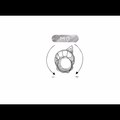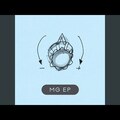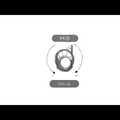Martin Gore, a founding member and principal songwriter of Depeche Mode, has released his first album in a dozen years: the all-instrumental MG, which lives somewhere between EDM and a cinematic score. He shares insights about his recording process and his favorite musical tools.
Martin Gore
ON THE ELECTRONIC ROCK HERO’S SOLO ALBUM, IT’S ALL ABOUT SYNTHS
BY FRANCIS PRÈVE
Vince Clarke on the VCMG project,"Martin Gore says, explaining his new synthsoaked solo outing, MG. “I thought this would be for the sake of doing something different, just to try and create something a bit more filmic, a bit more atmospheric, really, and get a whole album’s worth of that sort of material.”
For a recording with the cinematic scope of MG, Gore’s intuition is spot-on. His first full-length album since 2003’s Counterfeit 2 straddles the line between modern electronic dance music and lush soundscapes that could be a lost collection of cues from Blade Runner, deftly blending his brilliant and deep sense of sound design with an understated musicality that references the more somber and foreboding moments of his work as principal songwriter in the legendary electronic rock band Depeche Mode. The result is an album that’s equally suited to both casual listening and focused artistic inspection. Gore generously shared his insights into the recording process of MG, the current state of the music industry, and his favorite synths and modular gear.
With a record as technically intricate yet emotionally engaging, what was your production process for MG?
Well, I’ve always written instrumentals over the years and there have been quite a few that have come out as part of Depeche Mode albums or as extra tracks on singles. We actually put out a boxed set of just instrumentals that we’ve released. But when I was writing “Delta Machine” I actually had about four tracks or so that we decided not to use, so I thought, rather than let them go to waste, maybe I should think about doing an instrumental album and it would be something very different. So I built on that foundation that I had with those four tracks and started working on it pretty much straightaway when I got back from the “Delta Machine” tour. I just had this idea not to let anything linger for too long. I didn’t want any, like, nine-minute tracks. I wanted to keep it all kind of simple and short. Simple and short tracks evoke really special atmospheres. There was something that was a little bit sci-fi in the atmosphere that was being created on a lot of the tracks, so that gave me a bit of a template.
What DAW did you use?
I still work in [Apple] Logic Pro. Nearly all the sounds are created with hardware synths, however.
What synths did you use for the production?
A lot of it was created with modular synthesizers. I have a very big Eurorack system. There’s so much stuff now coming out in the Eurorack field, it’s unbelievable. It’s flourishing, it just doesn’t stop, and I find it so inspiring.
With all that modular gear, are there any modules you find yourself relying on regularly?
It depends obviously on what I’m doing but I like a lot of the Noise Engineering stuff and the Hex Inverter stuff and MakeNoise, of course, as companies. But I love the new Circadian Rhythms by TipTop Audio – that’s a great drum computer. During the recording I was using things like the Trigger Riot and the Noise Engineering drum module where you make your own sounds. And, then there’s another where you’ve got the “mother” rhythm and the three “child” rhythms. [Gore is referring to Noise Engineering’s Zularic Repetitor. —Ed.]
Was your rig exclusively modular or did you use any more conventional hardware synths?
I did use some more conventional stuff. I mean, I love my Elka Synthex. I use that on quite a few tracks. I use a Moog Voyager on one track, I think. Then I’ve also got a Synthesizers Dot Com modular system which I used quite a bit.
In terms of developing the sound of the record, how long did the process take, going from the original four fragments to building an entire album?
Well, the four fragments were more like four tracks that had been written, so they were about 80 or 90 percent there. We got back from the tour in March of last year, and I think I’d finished all of the recording by the end of November. It was pretty quick especially since I wasn’t doing really long days. Most days I would start around 12 o’clock and be finished by 6 or 7.
Several of the tracks, including “Pinking,” “Swanning,” and “Stealth,” have synth passages that evoke early Depeche Mode.What were your thoughts about going back to a more traditional analog tonal palette?
I don’t think it was anything that was conscious. It was probably just the fact that I was using a lot of analog stuff and maybe it’s just the way that I write—and inevitably, that’s going to evoke something from the past.
Quite a few tracks don’t include drums but still have a very strong rhythmic component. What are your thoughts on how those could be reinterpreted—or are you even thinking in terms of remixes?
Yeah, I am getting some remixes done of “Europa Hymn” and I already have one in at the moment and we’re waiting on about three more coming in. And then I have one remix of “Brink” that has already come in. And I think there’s another one we’re still waiting for.
Are you able to talk about who’s doing the remixes?
I can tell you the ones that are in already. I think that’s fine because the problem with remixes is that one always has to have veto power, so until I’ve actually heard them and actually like them, then it’s a bit of a grey area. But so far, I have Christopher Berg, who worked with us on “Delta Machine,” and he did a remix for VCMG as well. He’s done a remix of “Pinking.” And Virgil Enzinger did two remixes of “Brink.” All of those remixes so far are really good.
Will those be a separate package from the record, included as a bonus package, or will they be singles?
I think “single” is a bit of a weird term when you’re talking about an instrumental album or an instrumental track. But I think it may be like a lead track… there’ll be some remixes coming out as a download or on a single or… I imagine we’ll be doing it on vinyl as well these days. Vinyl is back! That’s the reason the album is coming out so late. The pressing plants were backed up because of Record Store Day. We have to push back the release of the record to wait for the vinyl. I never thought I’d be saying that in 2015.
Depeche Mode has certainly had a massive impact on the current electronic music landscape. But what modern artists, if any, are influencing you these days?
I listen to a lot of electronic music. I like things like Alva Noto and I love the Diamond Version albums. I think they’re very innovative and have a unique sound that no one else has.
Is that what draws you to new artists?
Whether it’s electronic or a band, I think that, yes, the draw is its uniqueness. You have to have your own special quality because a lot of stuff can sound very generic such that it’s very difficult to tell one artist from another. I don’t think you can ever mistake an Alva Noto track or a Diamond Version track for something else.
With a career that spans over three decades and has influenced thousands of musicians, what are the biggest lessons that you’ve learned that you’d like to share with our readers?
The landscape has changed so much. Even when I talk to members of my own family or people that are starting out now, I feel like Depeche Mode had such a head start due to the fact that the music industry was so much stronger when we started. If I were starting out now I wouldn’t even know where to begin. It seems to be so difficult to break into because record companies just don’t have the money anymore so they’re not interested in growing an artist.
What would you say to somebody who’s just getting into synths? What would you encourage?
I’ve always said, develop your own identity so that you put your stamp on something when you write or produce a track.
MARTIN GEAR!
Martin Gore talks about the principal synths on MG, and how they contributed to specific tracks.
Elka Synthex. The Elka Synthex is one of my favorite keyboards of all time—even with its digitally controlled oscillators. It has a great multi-mode filter. It is the kind of synth that’s impossible to make bad sounds with. All of the main melody sounds on “Elk” were played on it.
Minimoog Voyager. “Europa Hymn” was started with two interweaving sounds created on the Voyager played through a tape
echo.
Gleeman Pentaphonic. The clear-case Gleeman Pentaphonic is one of the coolest looking synths. I also like the mechanical feel of the preset changer. It has a sound unlike any other synth. It can be very glassy sounding, for want of a better word. I used it for the two-note melody in what I call the chorus of “Europa Hymn.”
Elektron Analog Four and Rytm. The Analog Four and Rytm were the starting point for “Creeper.” The Analog Four playing the repetitive and menacing bass line and the Rytm playing the high-end percussion.
ARP 2600 and Solina. The ARP 2600 was the first legendary synth that I saw in the flesh. When Depeche Mode went into the studio for the first time with Daniel Miller, he brought along his beloved machine. He was a master with it. He taught us so much about the potential of synthesizers. He also had an ARP sequencer which became a staple on our early records. I used the 2600 for one of the many groovy bass throbs on “Featherlight.” I used the ARP Solina for two of the parts on “Stealth.” One is more of a standard string sound. The other was put through a Doepfer Bit Modifier and ended up sounding more like a yodeling choir.
Aries/Digisound Modular. I have a hybrid Aries/Digisound modular. The main riff on “Creeper”—if you can call it that, as it’s fairly atonal—was created with this system. The Digisound oscillators are digital and the main component of the sound was created by scanning through their wave shapes.
Synton Fenix. The Synton Fenix is another of my favorites. In fact, I like everything I’ve ever tried or seen that was made by Synton. The main machine-like throb of “Hum” and the filtered background sound that plays most of the way through it were all the Fenix.
Dewanatron Swarmatron. The Swarmatron was responsible for the banshee screaming sound that comes in when “Spiral” kicks in after the small drop-down. I find the Swarmatron quite hard to control but inspiring because of that.
Octave Plateau Voyetra 8. The Voyetra 8 is another classic, another synth that always sounds good. I used it for the lush minor seventh chords on “Exalt.” They sound so beautiful amid the rest of the controlled chaos that’s going on.
Arturia MiniBrute. The MiniBrute had two duties on “Southerly.” Firstly, I made a hi-hat sound and played it with the arpeggiator, switching the timing to get it to play frenetic fills. Second, I used it for the punchy, midrange sequencer line.
A cikk eredetije itt olvasható:
http://www.dmtvarchives.com/forum/index.php?topic=874.msg18936#msg18936





